The Ripeness Indicator Labels Market is estimated to be valued at USD 3.7 million in 2025 and is projected to reach USD 6.4 million by 2035, registering a compound annual growth rate (CAGR) of 5.7% over the forecast period.
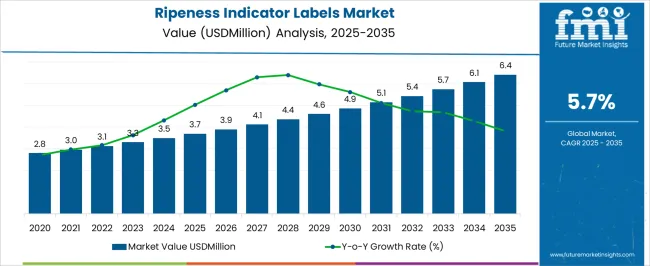
| Metric | Value |
|---|---|
| Ripeness Indicator Labels Market Estimated Value in (2025 E) | USD 3.7 million |
| Ripeness Indicator Labels Market Forecast Value in (2035 F) | USD 6.4 million |
| Forecast CAGR (2025 to 2035) | 5.7% |
The ripeness indicator labels market is experiencing steady momentum due to rising consumer demand for freshness monitoring solutions and the growing importance of smart packaging in perishable goods. These labels are increasingly being adopted in the food and beverage sector to reduce food wastage, improve shelf management, and enhance consumer trust.
Technological innovations in indicator materials, combined with growing investments in intelligent packaging formats, are driving widespread adoption across fresh produce and dairy categories. Regulatory emphasis on food safety and traceability is also supporting the integration of smart labeling systems.
The market outlook remains strong as stakeholders prioritize sustainability and efficiency within global supply chains, enabling ripeness indicator labels to play a vital role in quality assurance and consumer engagement.
The market is segmented by Material Type, Thickness, and Printing Technology Type and region. By Material Type, the market is divided into Paper and Plastic. In terms of Thickness, the market is classified into Less than 40 microns, 40 to 100 microns, 100 to 150 microns, and Above 150 microns. Based on Printing Technology Type, the market is segmented into Digital printing, Flexographic printing, Offset printing, and Others. Regionally, the market is classified into North America, Latin America, Western Europe, Eastern Europe, Balkan & Baltic Countries, Russia & Belarus, Central Asia, East Asia, South Asia & Pacific, and the Middle East & Africa.
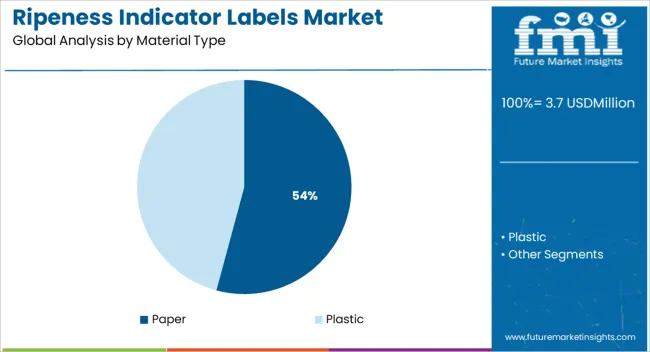
The paper material type segment is expected to contribute 54.20% of total revenue by 2025, making it the leading material choice. Its dominance is supported by cost effectiveness, wide availability, and compatibility with eco friendly packaging initiatives.
Paper based labels are also easily customizable and recyclable, aligning with sustainability mandates in the packaging industry.
Lightweight properties and flexibility in design have further driven adoption, positioning paper as the most preferred material for ripeness indicator labels.
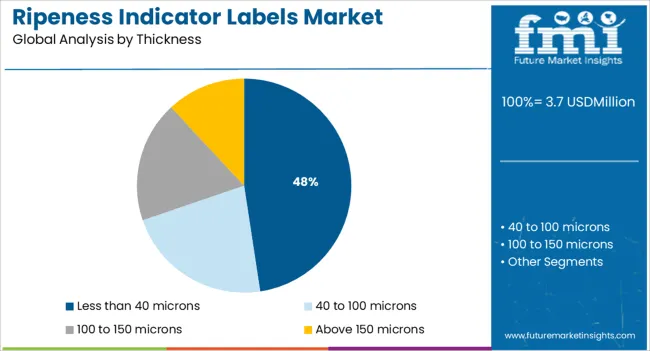
The less than 40 microns thickness segment is projected to account for 47.60% of the overall market revenue by 2025, establishing it as the dominant thickness category.
Its leadership is driven by lower material consumption, cost savings in production, and compatibility with compact label applications.
This thickness range supports precision printing, enhanced adhesion, and efficient scalability in mass production, contributing to its widespread preference.
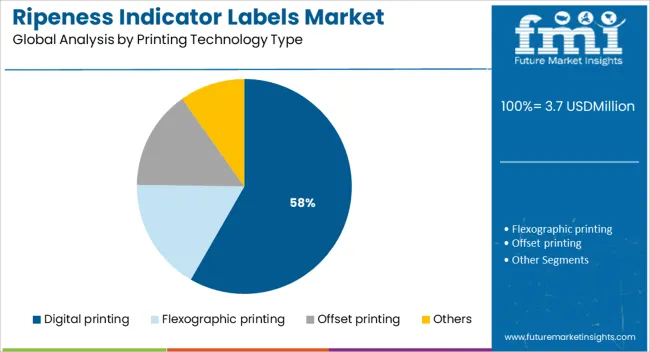
The digital printing technology segment is anticipated to hold 58.30% of the total market revenue by 2025, making it the most prominent printing technology type. This growth is being propelled by increasing demand for high quality, customizable, and short run printing solutions.
Digital printing provides superior color accuracy, faster turnaround times, and reduced setup costs compared to conventional printing methods.
Its adaptability to variable data printing and ability to support personalized packaging campaigns have further reinforced its market dominance.
The global ripeness indicator labels market expanded at a CAGR of 3.4% during the historic period and reached USD 3.7 Million in 2025.
Ripening is a development in fruits that causes them to become more pleasant to taste. Fruits become sweeter, juicer, and softer after seasoning. Aroma is released by the fruits as they season. As the fruit maturation cycle is completed ethylene is produced to induce a signal and starch breakdown is enlarged inside the food. Ripeness indicator labels indicate the ripeness of the fruits & shelf life at different time intervals it’s a new way to measure the ripeness of fruits.
Ripeness indicator labels whiff the aroma and changes its color. According to the fruits, each color is demonstrated by the manufacturers to recognize the period of fruits to the consumers. Maturity color variations according to fruits. Every fruit has different ripening stages. Climacteric fruits evolve fully if they are garnered at the completion of their progress period & non-climacteric fruits can develop fully only if they are allowed to continue attached to the maternal plant. Ripeness indicator labels are a better solution to allay this problem.
Ripeness indicator labels are expected to ring significant efficiencies to the fresh produce industry by reducing the surplus. Intelligent & Innovative packaging solutions such as ripeness indicator labels are been implemented by several brands for fruits. the increasing need for monitoring product quality and ensuring customer satisfaction fuels the demand for ripeness indicator labels. This helps manufacturers improve customer satisfaction & loyalty.
The development of several types of smart and intelligent labeling and packaging products has supported the major players in the fresh produce industry to safeguard that the products reach the final consumers with their ripeness intact. As buyers are getting information through ripeness indicator labels technology it has driven the market upward as transparency and food safety is increased. This technology has also worked as evidence.
As quality is a concern part of the food industry collaboration between agriculture & technology has given a chance to consumers to trust the manufacturers. As appropriate information is given by ripeness indicator technology consumers are not consuming unripe fruits and decaying fruits which cause medical issues like stomach - aches & food poisoning. This has helped manufacturers regain customer loyalty after Covid - 19. Thus, All these above-mentioned trends are fueling the global expansion of ripeness indicator labels across the globe.
Due to the recent crisis, consumers are getting aware of health issues. As Covid - 19 gave a lesson to the world that spending money on healthy food is better than spending money on medical treatments. consumers are looking for natural and organic food compared to dried and processed food as it contains more vitamins, minerals, and antioxidants.
The constant checks made on certified organic products and the use of composed manure have helped move to organic food like fruits, vegetables & grains. Consumption of organic food is better for the environment and helps the economy of the country this has boosted the global ripeness indicator labels market.
The paper segment is projected to accelerate at a CAGR of 5.3% from 2025 to 2035. Active and intelligent packaging took grown in recent years due to innovations and technological developments. Labels are used in a product for identification and displaying information like size, capacity, and storage information. Paper material is majorly used in the labels industry as it is more sustainable and recyclable.
Paper provides great flexibility and clarity compared to other materials Different types of paper like fluorescent, foil, semi-gloss, and high-gloss papers are used. Adhesives like permanent, removable, rubber base and acrylic cold temperature are used according to paper to stick the paper. Fluorescent papers are available in bright colors like red, green, pink & orange. Clear polyester paper label is majorly used as they can withstand harsh weather condition and chemicals.
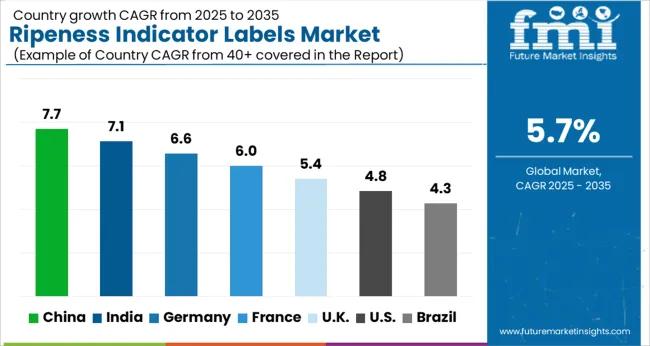
The world is getting more health conscious packaged food plays a key role in their life. Packaged food increases the shelf life, improves the quality, and protects the food against tampering. Most youths are consuming healthy raw food like fruits & vegetables as they have a good source of vitamins & minerals compared to processed food ripeness indicator labels will have high demand.
India has one of the largest populations of youth that is health conscious. India will contribute major dough at a fast pace in uprising the ripeness indicator market. According to India Brand Equity Foundation IBEF, India's packaged food market is going to double in the next 5- 10 years due to the rising economy & e-commerce trends. Ripeness indicator labels will have sturdy growth in India and are projected to grow X times the current market value during the forecast period.
According to the FMI analysis, China is projected to hold nearly 6.1% of the total world market for ripeness indicator labels during the forecasted years. According to China.Org. Cn & International Tropical Fruits Network China is the world's largest fruit and vegetable producer and Importer in the world for a long time. As China is one of the leading importers of fruits for several years ripeness indicator labels will help china to increase the import of climatic fruits as information will be displayed on packages. This will help them to regain the economy which hamper in pandemic situations. China will play a major role in increasing the market value of ripeness indicator labels.
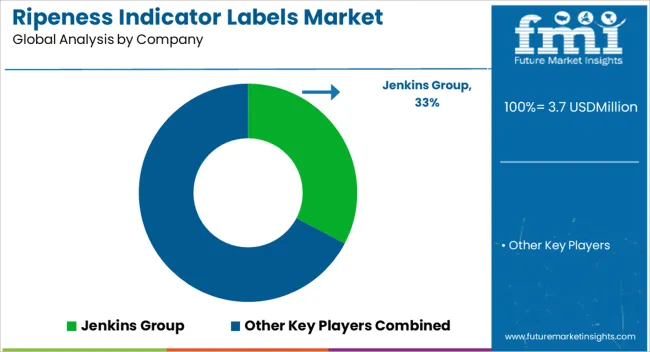
The key players manufacturing ripeness indicator labels are trying to focus on innovation by launching new products along with adopting the advancement in technology to cater to the demand. Also, the players are expanding their production capacity to meet the demand for smart, connected, and interactive packaging across the globe.
As it’s a new innovation in the market companies have scope to enter & increase the sales of ripeness indicator labels.
| Attribute | Details |
|---|---|
| Growth Rate | CAGR of 5.7% from 2025 to 2035 |
| Base Year for Estimation | 2025 |
| Historical Data | 2020 to 2025 |
| Forecast Period | 2025 to 2035 |
| Quantitative Units | Revenue in USD Billion, Volume in Units, and CAGR for 2025 to 2035 |
| Report Coverage | Revenue Forecast, Volume Forecast, Company Ranking, Competitive Landscape, Growth Factors, Trends, and Pricing Analysis |
| Segments Covered | Material, Thickness, Printing Technolog Type |
| Regions Covered | North America; Latin America; East Asia; South Asia & Pacific; Western Europe; Eastern Europe; Central Asia; Russia & Belarus; Balkan Countries; Baltic Countries; Middle East and Africa (MEA) |
| Key Countries Covered | United States of America, Canada, Mexico, Brazil, Germany, United Kingdom, France, Italy, Spain, Russia, China, New Zealand, India, GCC countries, Australia |
| Key Players |
Jenkins Group |
| Customization & Pricing | Available upon Request |
The global ripeness indicator labels market is estimated to be valued at USD 3.7 usdmillion in 2025.
The market size for the ripeness indicator labels market is projected to reach USD 6.4 usdmillion by 2035.
The ripeness indicator labels market is expected to grow at a 5.7% CAGR between 2025 and 2035.
The key product types in ripeness indicator labels market are paper and plastic.
In terms of thickness, less than 40 microns segment to command 47.6% share in the ripeness indicator labels market in 2025.






Our Research Products

The "Full Research Suite" delivers actionable market intel, deep dives on markets or technologies, so clients act faster, cut risk, and unlock growth.

The Leaderboard benchmarks and ranks top vendors, classifying them as Established Leaders, Leading Challengers, or Disruptors & Challengers.

Locates where complements amplify value and substitutes erode it, forecasting net impact by horizon

We deliver granular, decision-grade intel: market sizing, 5-year forecasts, pricing, adoption, usage, revenue, and operational KPIs—plus competitor tracking, regulation, and value chains—across 60 countries broadly.

Spot the shifts before they hit your P&L. We track inflection points, adoption curves, pricing moves, and ecosystem plays to show where demand is heading, why it is changing, and what to do next across high-growth markets and disruptive tech

Real-time reads of user behavior. We track shifting priorities, perceptions of today’s and next-gen services, and provider experience, then pace how fast tech moves from trial to adoption, blending buyer, consumer, and channel inputs with social signals (#WhySwitch, #UX).

Partner with our analyst team to build a custom report designed around your business priorities. From analysing market trends to assessing competitors or crafting bespoke datasets, we tailor insights to your needs.
Supplier Intelligence
Discovery & Profiling
Capacity & Footprint
Performance & Risk
Compliance & Governance
Commercial Readiness
Who Supplies Whom
Scorecards & Shortlists
Playbooks & Docs
Category Intelligence
Definition & Scope
Demand & Use Cases
Cost Drivers
Market Structure
Supply Chain Map
Trade & Policy
Operating Norms
Deliverables
Buyer Intelligence
Account Basics
Spend & Scope
Procurement Model
Vendor Requirements
Terms & Policies
Entry Strategy
Pain Points & Triggers
Outputs
Pricing Analysis
Benchmarks
Trends
Should-Cost
Indexation
Landed Cost
Commercial Terms
Deliverables
Brand Analysis
Positioning & Value Prop
Share & Presence
Customer Evidence
Go-to-Market
Digital & Reputation
Compliance & Trust
KPIs & Gaps
Outputs
Full Research Suite comprises of:
Market outlook & trends analysis
Interviews & case studies
Strategic recommendations
Vendor profiles & capabilities analysis
5-year forecasts
8 regions and 60+ country-level data splits
Market segment data splits
12 months of continuous data updates
DELIVERED AS:
PDF EXCEL ONLINE
Flow Indicator Market Size and Share Forecast Outlook 2025 to 2035
Oxygen Indicator Labels Market Size and Share Forecast Outlook 2025 to 2035
Market Leaders & Share in Oxygen Indicator Labels Manufacturing
Grating Indicator Calibrator Market Size and Share Forecast Outlook 2025 to 2035
Chemical Indicator Inks Market Size and Share Forecast Outlook 2025 to 2035
Humidity Indicator Plugs Market
Freshness Indicator Label Market Size and Share Forecast Outlook 2025 to 2035
Biological Indicator Vial Market Size and Share Forecast Outlook 2025 to 2035
Breaking Down Market Share in Biological Indicator Vial Industry
Colorimetric Indicator Labels Market Trends – Growth & Forecast 2024-2034
Rotation Speed Indicators Market Size and Share Forecast Outlook 2025 to 2035
Steam Chemical Indicator Market
Pharmaceutical Indicator Strips Market
Cable Line Fault Indicator Market Size and Share Forecast Outlook 2025 to 2035
Time Temperature Indicator Label Industry Analysis in Western Europe Size and Share Forecast Outlook 2025 to 2035
Time Temperature Indicator Labels Market Size and Share Forecast Outlook 2025 to 2035
Evaluating Time Temperature Indicator Labels Market Share & Provider Insights
Blood Temperature Indicator Market Size, Share & Forecast 2025 to 2035
Competitive Landscape of Blood Temperature Indicator Providers
Biological and Chemical Indicators Market Insights - Trends, Growth & Forecast 2025 to 2035

Thank you!
You will receive an email from our Business Development Manager. Please be sure to check your SPAM/JUNK folder too.
Chat With
MaRIA